Wat Phra That Doi Kham – The Famous 1300-year-old Temple
Wat Phra That Doi Kham, also recognized as the Temple of the Golden Mountain, has a legendary charm that can entice any seasoned globetrotter. Nestled atop Doi Suthep mountain, approximately 10 km (6.2 miles) southwest of Chiang Mai City, this captivating destination promises more than a stunning panorama; it promises a spiritual journey of a lifetime, right from the base of the 300-step climb to its apex.
Wat Phra That Doi Kham is near Royal Park Rajapruek and the Night Safari. Cat Motors provides scooter rental in Chiang Mai so riders can visit all three easily. Options include 125–160 cc for short loops and 300–350 cc for extended countryside rides.
From its shrines to its courtyards, every nook of the temple mirrors beauty in its purest form. Adding to this allure is the mesmerizing view of Chiang Mai city that you can soak in from the hilltop. The temple compound also houses a towering 17 m/56 foot Buddha, the Speakable Buddha, draped in golden robes. The majestic sight of standing and reclining Buddhas only adds to the spiritual allure of this revered sanctuary.
Wat Phra That Doi Kham holds a special place among the local community, even more so than among tourists. The temple shot to fame after an intriguing event involving a lucky lottery winner. Ms. Thanyathip, affectionately known as “Sister Pa,” had come to offer prayers here after winning the first prize in the lottery draw on December 1, 2019. She won 5 tickets that totaled an impressive 30 million baht, along with an additional bonus of 500,000 baht for another 5 tickets, summing up to a whopping 30.5 million baht (US$1.009.550).
This remarkable story triggered a surge in believers flocking to the temple in hopes of their own miraculous windfall. Today, Wat Phra That Doi Kham is a sought-after destination for those looking to pray for prosperity, hoping to replicate “Sister Pa’s” good fortune.
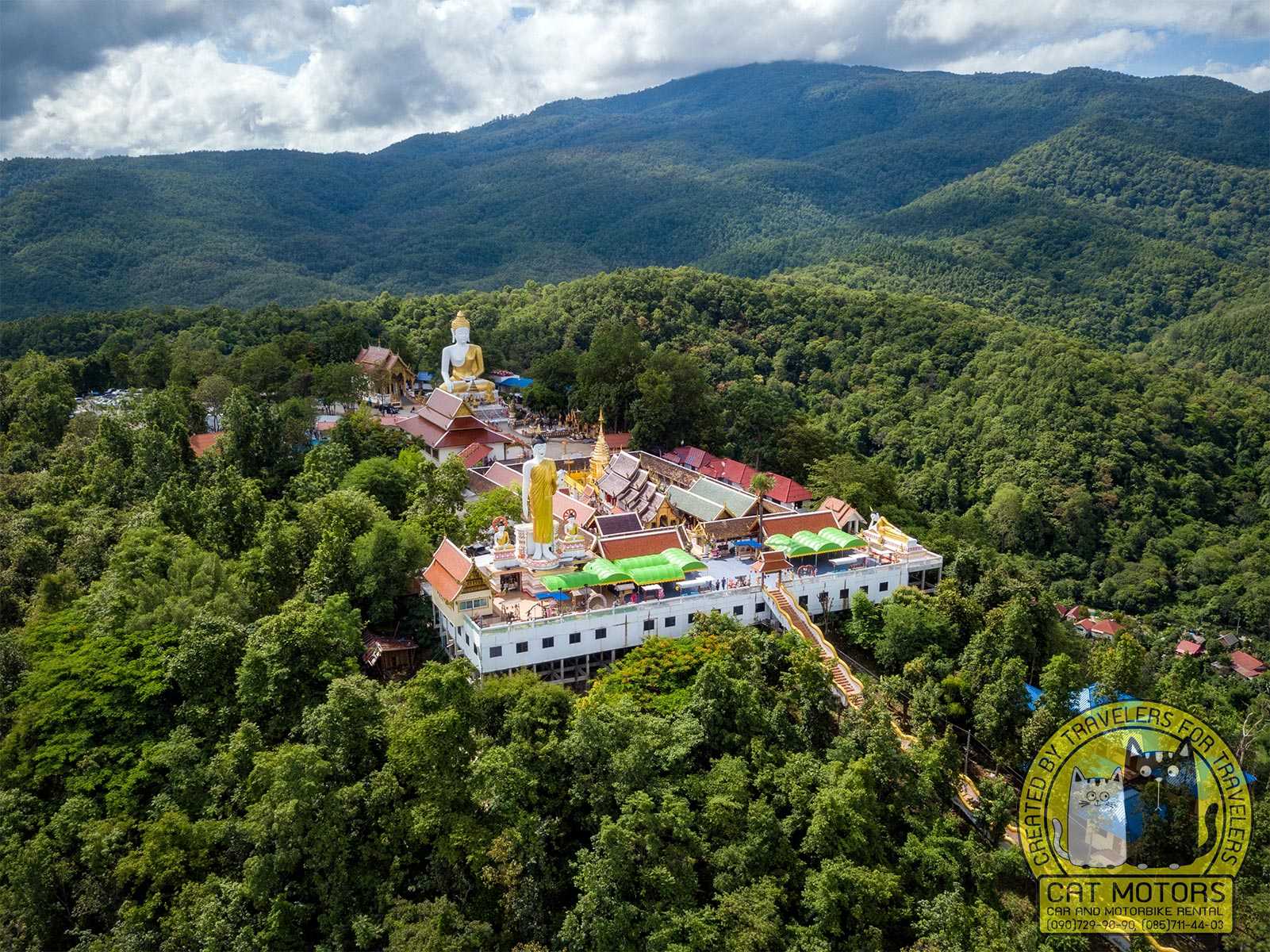
As a seasoned traveler, stepping foot into a 1300-year-old monument like Wat Phra That Doi Kham is an exhilarating experience. The grandeur of this ancient temple inextricably interweaves the tales of time, the legend of Buddha, and the faith of local people that has passed through the centuries. If only these walls could recount their tales, what great chronicles we would hear!
Exploring the rich heritage of Thai temples is a breathtaking experience, but it comes with a responsibility to adhere to their dress code. Wat Phra That Doi Suthep, for instance, maintains a strict dress code to preserve the sanctity of the site. Discover more about the attire guidelines at Wat Phra That Doi Suthep by visiting their informative page, and embark on a journey of cultural reverence.
The inception of this temple dates back to around 687 AD, during the reign of Queen Camadevi, the inaugural ruler of the Haripuñjaya Kingdom. The golden chedi, a true masterpiece, was built by her two sons as a shrine to house precious relics of the Buddha, including a strand of his hair.
However, time took its toll, and the chedi was eventually abandoned. Yet, the tale of this majestic structure took an interesting turn in 1966 when a heavy downpour caused it to crumble, revealing a hidden chamber inside. This chamber was a veritable treasure trove, holding many Buddha images and the sacred relic that was believed to have been lost.
Recognizing the enormous spiritual and historical significance of their discovery, the local villagers rallied to raise funds for the restoration of the chedi. Today, Wat Phra That Doi Kham stands not just as an architectural marvel but as a testament to the enduring faith and determination of a community that has reverently preserved its spiritual heritage across the ages.
Myths & Legends of Wat Phra That Doi Kham
The narrative fabric of Wat Phra That Doi Kham is richly woven with intriguing myths and legends that add an extra layer of fascination to this timeless destination.
One such tale involves a ferocious cannibal family, comprising Pu Sae, his wife Ya Sae, and their son Sudeva. Depending on the storyteller, this notorious family could have been giants, shapeshifting demons, or ancestors of the Lawa tribe residing in the Doi Suthep mountains.
These ruthless beings, renowned for their people-eating rampage, had their eyes set on none other than the Buddha himself. Yet, foreseeing their intentions, the Buddha stamped his foot onto a rock with such might that it left an everlasting footprint. This footprint has since evolved into a shrine revered by many.
This display of power stunned the cannibal family into forsaking their gruesome diet, marking their conversion to Buddhism. Despite their newfound faith, they struggled to overcome their cravings for human flesh. They pleaded with the Buddha, first for one human meal a year, then every seven years, only to be denied each time. Ultimately, they agreed to substitute their favorite human meal with an annual water buffalo sacrifice, a ritual that persists to this day as part of a festival to usher in abundant rainfall.
In the heart of Wat Phra That Doi Kham, the Buddha placed a strand of his hair, a divine relic that is cherished even today.
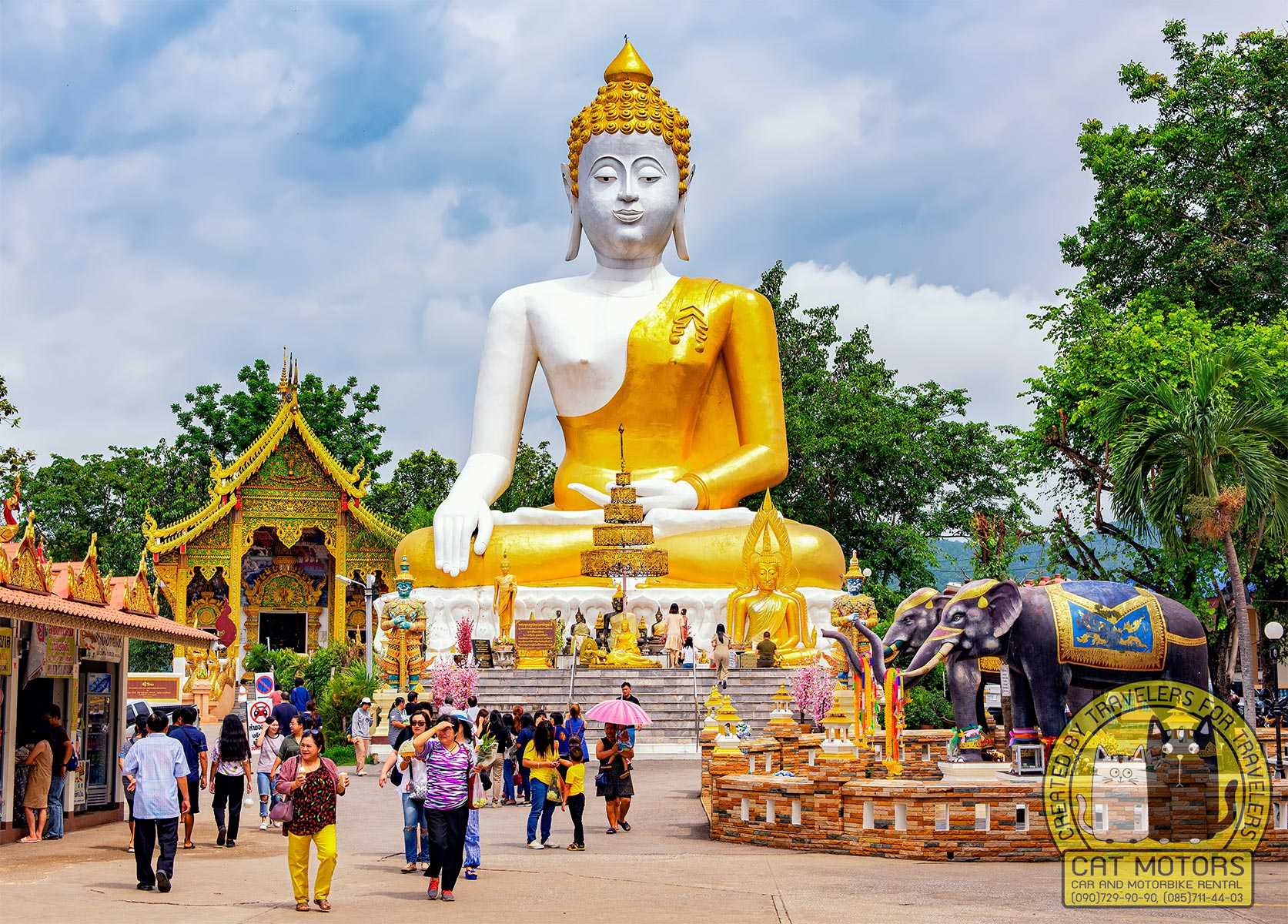
Another rendition of the tale paints the cannibals as Hindu demons (rakshasas) whose hostile intent towards the Buddha was transformed into reverence by his compassion. These converted demons vowed never to consume human flesh again, eventually becoming protectors of the temple.
This tale lives on in the form of shrines dedicated to Pu Sae and Ya Sae within the temple compound. Strangely enough, it is a common sight to see locals offering brand-new, still-wrapped dress shirts on their laps. While such practices may baffle an outsider, understanding the legends of the temple provides a rich context to identify the enshrined characters and the rituals surrounding them. As a seasoned traveler, knowing these tales enhances the experience, making every visit to Wat Phra That Doi Kham a walk through the lanes of history, faith, and folklore.
Architecture And Design
The Temple of the Golden Mountain’s glorious centerpiece is its golden pagoda, a spiritual beacon to the city down below. The pagoda is designed in a traditional Lanna architectural style, with its bell-shaped, multi-tiered structure decorated with intricately detailed carvings. The temple’s golden exterior proclaims its significance, and two giant Naga serpents guard the way to the pagoda.
Aside from the pagoda containing the Buddha’s relics, the compound consists of the monks’ dwelling, a pavilion, and many small shrines dedicated to the Buddha and numerous other deities. The site provides incredible panoramic views of Chiang Mai below. It borders the beautiful Royal Park Rajapruek, an exquisite botanical garden.
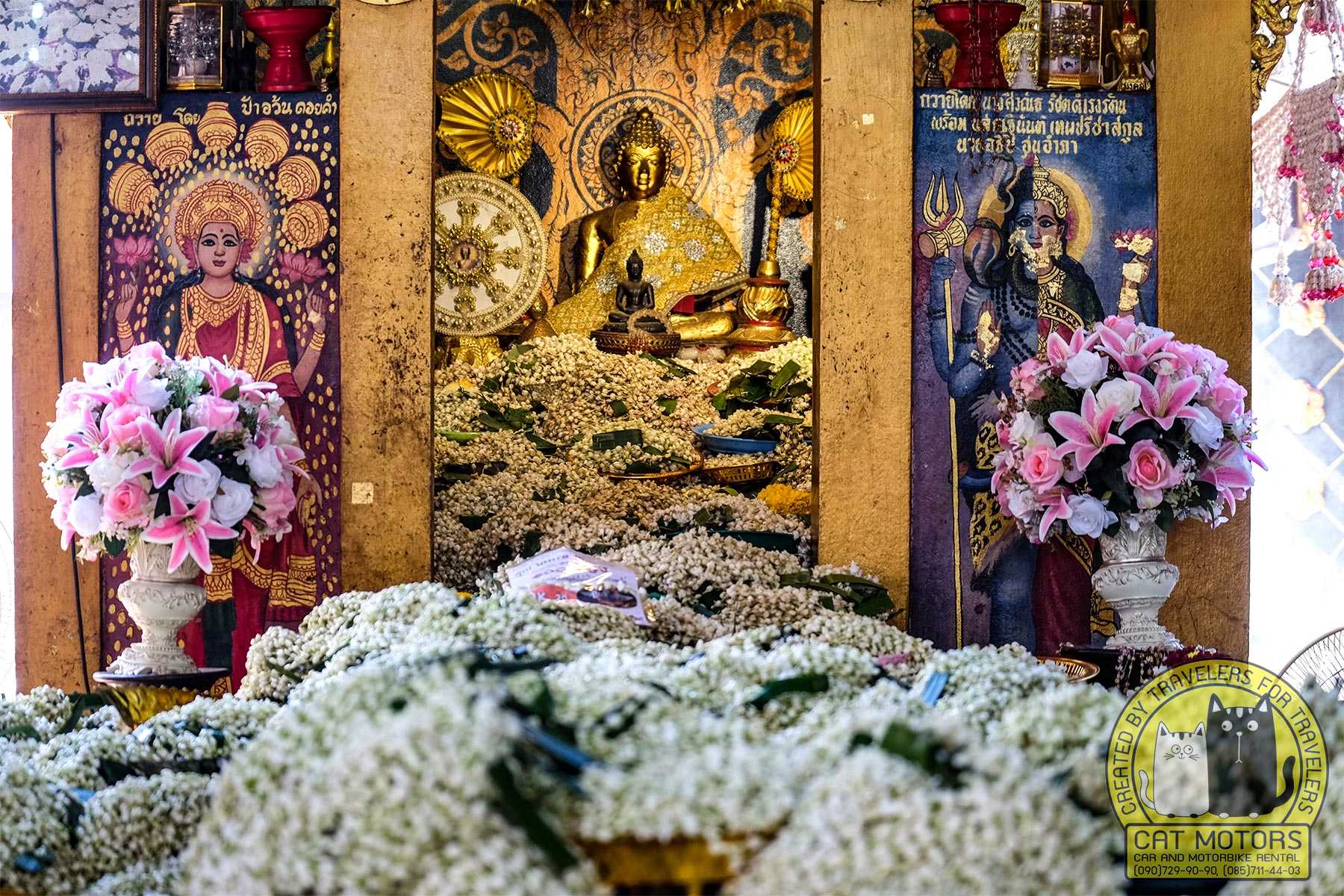
Exploring The Mystical Chedi
The chedi at Wat Doi Kham is a striking blend of architectural grandeur and spiritual sanctity. Its golden exterior and intricate designs captivate the eye, while the serene interior invites contemplation and reverence.
The exterior of the chedi is a sight to behold, characterized by its majestic golden appearance. The main structure is a multi-tiered pagoda with a square base. Golden decorations adorn the tiers with intricate designs of mythical creatures and Buddhist symbols such as lotus flowers and Naga serpents.
The chedi is coated in gold leaf, shimmering and gleaming when bathed in sunlight, reflecting far and wide the temple’s significance and sanctity. As visitors stroll through the compound, they will find many Buddha statues, prayer boxes where they can make donations, and bells they’re permitted to strike.
The interior has a serene and sacred ambiance. It is relatively compact, with a central area that houses the main Buddha image. Intricate murals adorn the walls, depicting colorful scenes from Buddhist teachings, mythology, and historical events.
A sacred image that draws crowds to Wat Phra That Doi Kham is “Luang Pho Than Jai,” the Buddha image that blesses the person when they make a wish, particularly regarding health and wealth. Gamblers who love the lottery often go there to pray for luck.
The central area has the Buddha image seated on a platform under soft lighting, creating a tranquil atmosphere. Flowers, candles, and other offerings from devotees and those praying for blessings surround the statue. They must state their name, wish, and how many jasmine garlands they will offer if granted.
Visit around the beginning of winter or within the winter season. You can experience cool and relaxing fresh air, perfect for those who have come to pay their respects and receive blessings to achieve peace of mind.
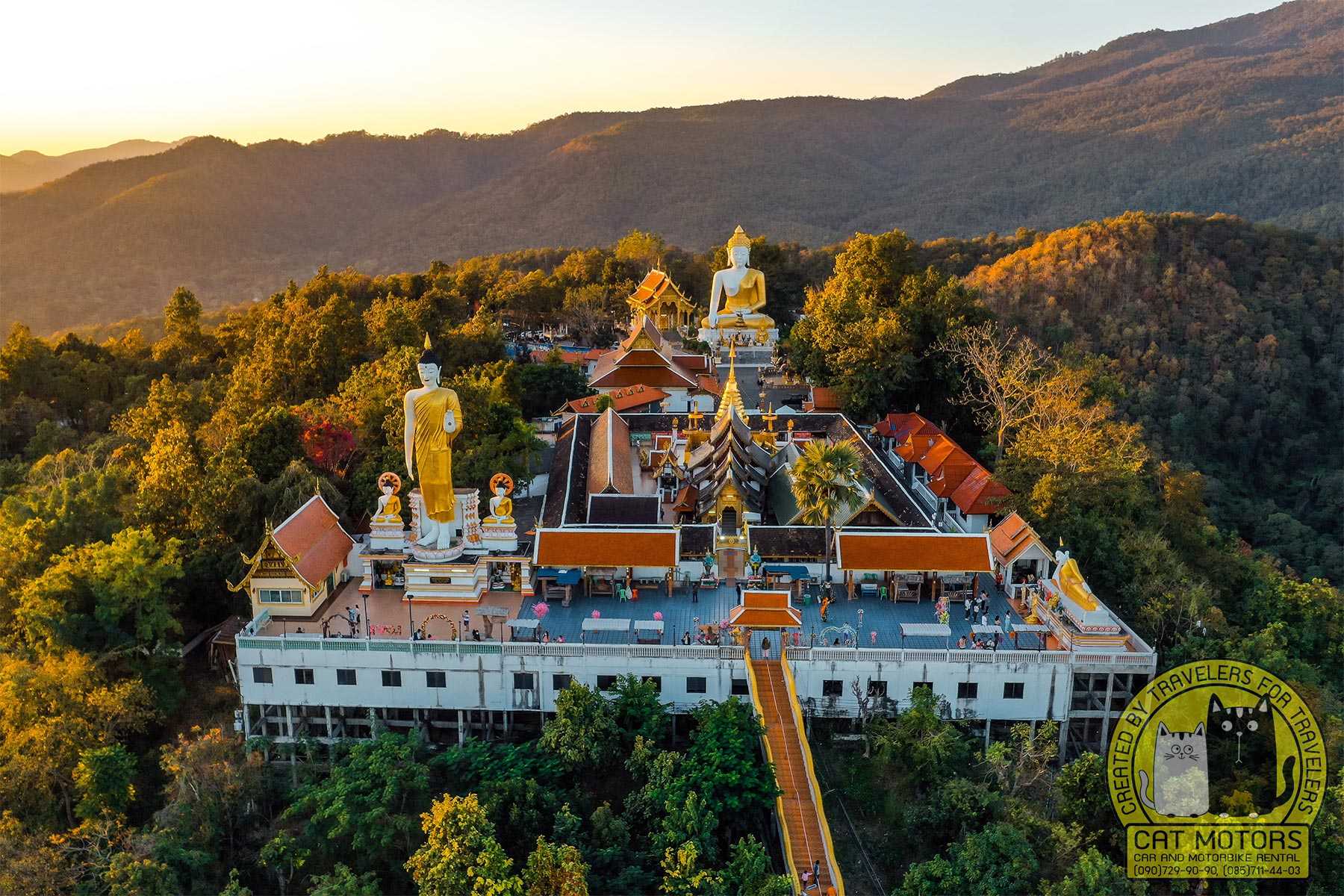
The Sacred Journey To The Temple Of The Golden Mountain
Tourists have several options to get to the temple if they don’t have their own transport. Many people hire a songthaew or a tuk-tuk for a round trip, where they can negotiate the fare. Such a trip will cost around 400 baht. Alternatively, they can hire a scooter or a private car. When hiring a scooter in Thailand, it’s highly recommended to buy travel insurance.
On arrival, visitors can go left if they’re driving to the drop-off point/parking area or right if they plan to take the 300 stairs. There is a cable car/elevator for those not wishing to climb. The site is wheelchair-accessible.
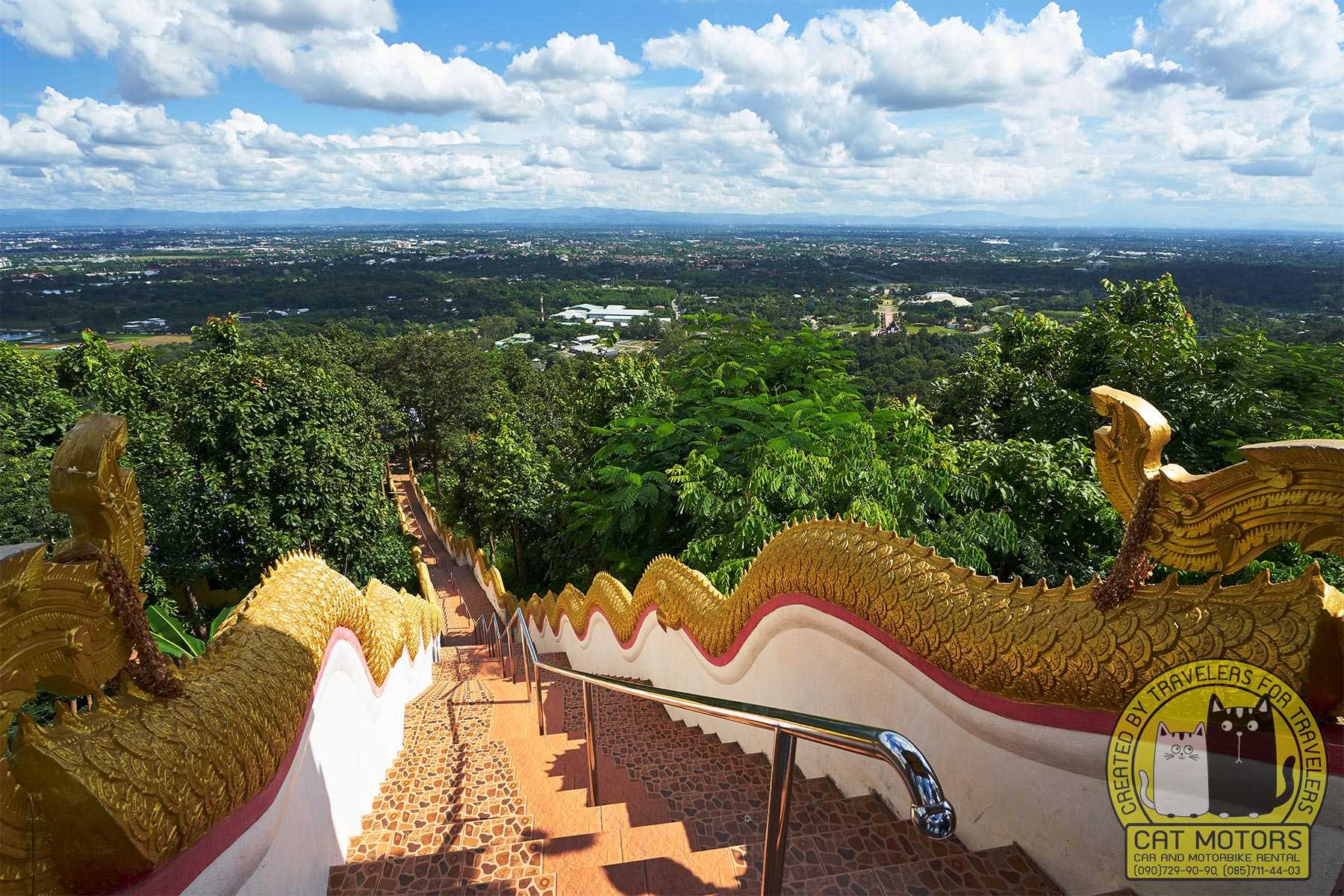
The golden temple opens between 8 AM and 5 PM. Entrance to the temple is free for locals but costs 30 baht for foreigners (farang). A tour can take 1-2 hours, including taking all the necessary photos for social media!
The best season to visit the temple is between November and March when the cool weather makes for a pleasant trek up the mountain with a lesser risk of rain. Clear skies also increase the likelihood of a better view of the city from the lookout points. For a quieter, more meaningful visit, early mornings and late afternoons provide the best views of the city of Chiang Mai.
As is customary at Buddhist temples, visitors should dress respectfully. When entering the temple, they should cover their shoulders, knees, and midriffs. Visitors should remember they will have to remove their shoes at the entrance to the temple. They leave them in a locker and retrieve them after viewing the sacred spot.
At the compound itself and below at the base of the mountain, visitors can purchase all manner of items, including food, drinks, and jasmine garlands, to name a few. They can even buy lottery tickets, as many locals do before they pray to Luang Pho Than Jai to win the jackpot.
Charming Attractions Close To Wat Phra That Doi Kham
With its stunning chedi and serene surroundings, the temple serves as a gateway to many nearby attractions. Embark on a journey to discover diverse and enchanting destinations within a short distance from the golden temple.
Royal Park Rajapruek
Royal Park Rajapruek lies just 3.3 km (2 miles) from the big Buddha statues at the temple. Royal Park Rajapruek (Google Map) is a sprawling botanical garden displaying plants and flowers from all over the world. The park is divided into different gardens, each representing separate countries.
The park is operational from 8 AM to 6 PM daily. Admission fees differ for Thai visitors and foreigners (Farang):
Thai adults: 100 baht
Thai children 100 – 140 cm: 70 baht
Foreign adults: 200 baht
Foreign children 100 -140 cm: 150 baht
Chiang Mai Night Safari
Chiang Mai Night Safari (Google Map) is a popular and exciting tourist destination situated only 4.7 km (less than 3 miles) from Wat Phra That Doi Kham at the foot of Doi Suthep in the Doi Suthep-Pui National Park. The Night Safari is the realization of Prime Minister Thaksin Shinawatra’s dream of a nocturnal zoo. It is separated into various tourist zones:
- Resort hotel where visitors can stay overnight
- The main building contains shops, animal viewing points, conference rooms, and activity areas
- The lake where visitors can watch a dancing fountain performance
- The Giraffe Restaurant offers both a la carte and buffet menus
Chiang Mai Night Safari opens at 11 AM daily and closes at 10 PM.
Baan Tawai Woodcarving Village
Baan Tawai Village (Google Map) is a must-visit destination for art enthusiasts and culture aficionados. This renowned handicraft village is 11.9 km (7.4 miles) from Wat Phra That Doi Kham. Baan Tawai Village is home to skilled artisans specializing in creating exquisite wood carvings, lacquerware, ceramics, and more.
One can easily spend several hours gazing at the handicrafts at the various shops and working up an appetite. Fortunately, there are numerous bars, restaurants, and coffee shops for refueling.
Wat Umong
10.1 km (6.3 miles) north of Wat Doi Kham lies the Tunnel Temple or Wat Umong (Google Map). What makes this 14th-century temple unique is that it consists of a series of tunnels, hence the nickname. It is famous for its tunnels and sizeable chedi built by King Mangrai of the Lan Na Kingdom.
Legend states that the king built these tunnels and painted them with wooded scenery to keep a well-known but mentally disturbed monk within the temple grounds, as he tended to disappear into the bush for days.
Opening hours: 8 AM – 5 PM daily, closed on public holidays
Map & Direction
Our Summary
Wat Phra That Doi Kham is a bright and colorful memorial symbolizing Thailand’s rich cultural heritage and deep-rooted Buddhist traditions. Its historical significance, architectural splendor, and spiritual importance make it a must-see destination for those seeking a profound connection with Thai culture and spirituality.
Once visitors have soaked up the serenity of this famous temple, it acts as a springboard for myriad attractions for the tireless tourist. Whether marveling at the intricate design, paying homage to the sacred relic, or finding solace in its peaceful surroundings, this temple promises a truly transformative experience.
FAQ
Wat Phra That Doi Kham is generally open to visitors from 8:00 AM to 5:00 PM daily.
As of the last update, there isn’t typically an entrance fee for the temple, but donations are encouraged for its upkeep.
Visitors are expected to dress respectfully, meaning knees and shoulders should be covered.
As of the last update, there were no guided tours. The temple is quite small and can be self-explored.
As a functioning Buddhist temple, it hosts regular religious ceremonies. Special events occur on Buddhist holidays and during the Thai New Year, or Songkran.
The temple is known for its large sitting Buddha statue and for the panoramic view of Chiang Mai city from the temple grounds.
Yes, visitors are typically allowed to take photos. However, always respect any signage indicating otherwise and refrain from disrupting worshippers.
Besides dressing respectfully, visitors should speak softly and remove their shoes when entering certain areas. It is also considered disrespectful to point feet towards Buddha images or monks.
The temple is located around 10 kilometers from the city center. Visitors can take a taxi, songthaew (a shared taxi), or rent a scooter.
The Royal Park Rajapruek and the Chiang Mai Night Safari are located nearby and could be combined with a visit to the temple.
Early mornings and late afternoons during weekdays are generally less crowded times to visit.
Explore Northern Thailand’s beauty with our comprehensive travel guides, highlighting the best scenic routes and local attractions. Start your journey by visiting our scooter rental in Chiang Mai homepage. Don’t forget to review our terms and conditions for a seamless experience. With these resources, you can confidently explore mountain trails and charming villages.
Our travel advice sections offer essential tips on staying safe and enjoying your trip to the fullest. Discover the best times to visit major attractions, local festival schedules, and how to handle different road conditions. These insights will make your journey richer and more enjoyable. Join us in uncovering the breathtaking landscapes and vibrant culture of Northern Thailand, ensuring a safe and memorable trip.
- Author: Natcha Lindberg
- Updated: 15/09/2025
- No Comments




